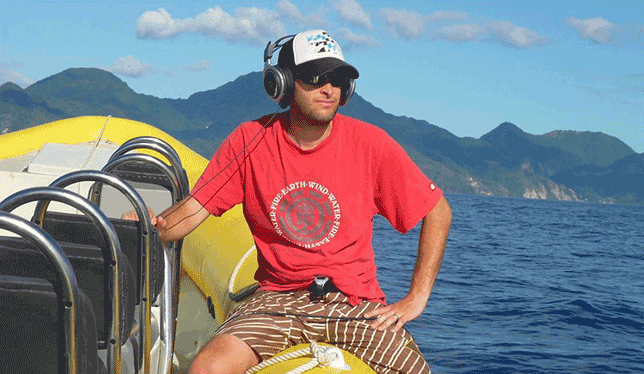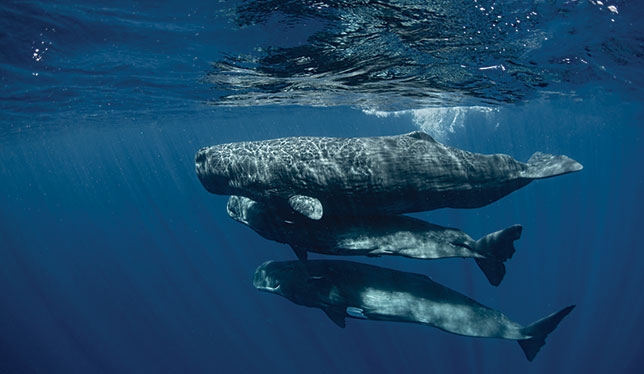Carleton University scientist in residence Shane Gero lives a double life. One plays out on dry land in Ottawa with his wife and three children – nine, seven and four years old – in a home filled with sperm whale-themed toys, t-shirts, knickknacks and assorted “gifts over the years,” he laughed.
The gifts reflect his other life. As founder and lead scientist of the Dominica Sperm Whale Project (DSWP), Dr. Gero spends months in the eastern Caribbean with the real thing: about 40 sperm whale families he has tracked, studied and bonded with, some for more than a decade.
“I’ve known some of these whales longer than I’ve known my own kids,” Dr. Gero says. “That’s my whale family and my human family is here in Ottawa. My kids know them although they haven’t yet met them.”

Dr. Gero didn’t grow up around big water, he was never a sailor and admits he was “definitely not the world’s best swimmer.” But he knew from the time he was about seven years old he wanted to be a marine biologist studying whales.
“There was this added mystery about what is it like to grow up as a nomadic family in the open ocean that was fascinating to me,” he says.
That childhood passion fuelled his professional path. When National Geographic won an Emmy in September 2021 for its series, The Secrets of Whales – filmed over three years in locations around the world – Dr. Gero, as scientific consultant, was integral to the project.
“My research and the science and storytelling from the Dominica Sperm Whale project was the foundation for that series,” he said.
Dr. Gero first became enamoured with sperm whales about 20 years ago while crewing on a research project in the middle of the north Atlantic’s Bermuda Triangle.
“It took two days to get from the Canadian cold water, through the Gulfstream, with really rough going through very strong currents,” he recalls. “We went to sleep in the cold, we woke up and it was warm and there were sperm whales. It was exhilarating!”
Sperm whales are the largest-toothed whale with the biggest brain of any known animal, about six times bigger than a human brain. A sperm whale can be as long as two school buses and weigh as much as ten buses and can do deep, nearly hour-long dives to forage for food. Sperm whale society is matrilineal with grandmothers, mothers and daughters living together for life.
“That is a foundational part of their society,” Dr. Gero says. “The females babysit and sometimes nurse each other’s young. Each family is a little bit different, but they do collectively raise, care for and defend the babies.”

Young males live within the family until their early teens, then become mostly solitary until they need to mate. “We don’t know a lot about the males,” he notes. “We know they have friends and sometimes live in bachelor groups, especially when they’re younger.”
Sperm whales communicate through rhythmic patterns of clicking sounds, “sort of like morse code,” Dr. Gero said. Some clicks are for navigation, while others are social calls or “codas” with each sperm whale family using at least two dozen different patterns of codas. Some even have different dialects. Dr. Gero wants to know what they are saying.
“We found that sets of families using these different sets of coda patterns also differ in where they mate, where they live, where they move and have differences in terms of social behaviour,” he said. “It’s kind of like comparing French culture and Cantonese and Canadian culture.”
To gain a deeper understanding of these codas, Dr. Gero is now partnering with Project CETI (Cetacean Translation Initiative). This collaboration of experts is looking to create new tools and technologies to record the ocean and understand whale communication at levels never previously attempted.
“The impact of investing a huge amount of time listening and getting to understand a non-human species will be profound,” he said. “I hope this is the fundamental lesson that comes out of this research.”
Felicitaciones, Shane, excelente trabajo y te lo mereces
We recently returned from a tour of observing the sperm whales in Dominica. Being a proud Canadian and familiar with academia research I am honoured to have gained an insight into the sperm whale. The tour guides on the catamaran described it perfectly and were available to answer all the questions. I hope the funding continues so this marine research continues for a very long time. It was fascinating and everyone took away knowledge & understanding of the sperm whales. Thank you!